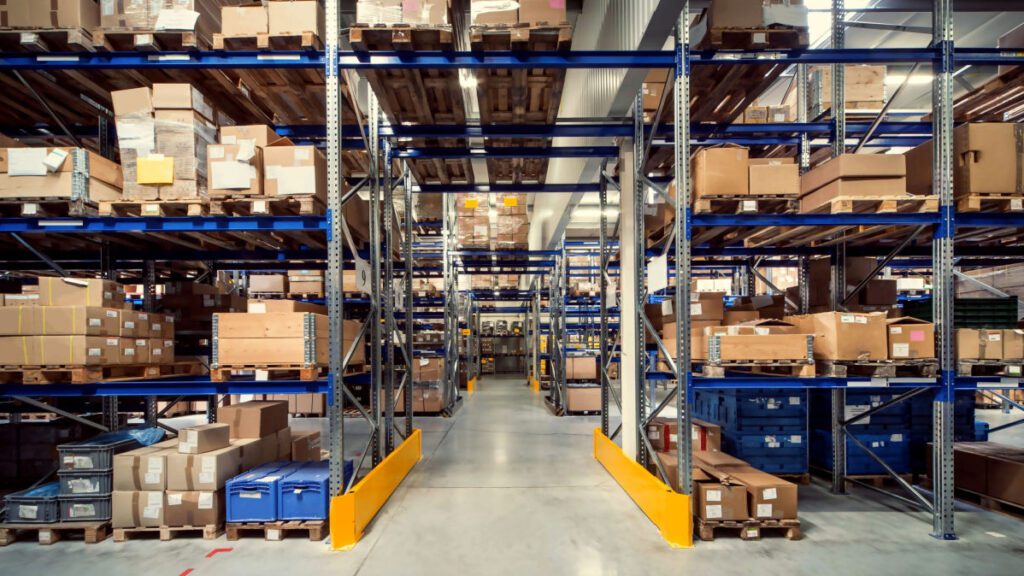Optimizing space in your warehouse or distribution center can be challenging. However, having the correct warehouse layout enables your operations to function efficiently.
A warehouse is considered out of space when it reaches 85% of its capacity. Anything at that point or above causes a drop in movement and storage efficiency. Pallet movement becomes restricted, requiring multiple actions and activities to replenish it.
At Diversified Rack & Shelving, we’re experts at providing storage solutions for your warehouse. As such, we’ve put together a list of 10 tips for optimizing space in your warehouse.
Tips for How to Optimize Space in Your Warehouse
Calculate Your Current Space Utilization
Start by determining how much of your warehouse is used by capacity and utilization. You want to know this information to decide which steps to take next.
Try to understand your current floor space and warehouse layout thoroughly. Analyze rack configuration, receiving, putaway, slotting/pick philosophy, replenishment, inventory management, packing, and shipping. Consider seasonal trends and analyze your volume of inbound and outbound product flow.
Extend Your Racking Vertically
Creating vertical space is usually easy to free up space in your warehouse or distribution center. For example, you can store products within 18 inches of the fire suppression sprinkler system in new buildings.
Look up to determine whether you’re using all the available vertical space. You probably already have pallet racks in your warehouse, so adding these and using a forklift and pallets is an effective way to maximize storage. Diversified Rack & Shelving has pallet rack installers who provide outstanding installation and dismantling services.
Reduce Aisle Width in the Racking Area
A wide aisle in a warehouse can range from 10 to 12 feet. If you reduce your aisle width to 5-8 feet, it’s possible to free 15-20% of the area for additional space optimization.
Of course, you must consider your lift equipment and whether it can navigate this potential space. Also, keep in mind that narrow aisles also have the added expense of wire guidance.
Evaluate and Change Your Storage Medium
You could also evaluate your storage medium and make the change to higher-density equipment. For example, you could go from a single-deep racking system to a double-deep one.
Double-deep racks need a reach truck for loading pallets.
You could also consider push-back or drive-in racks for higher-density equipment alternatives. These are excellent options for optimizing space in your warehouse, but higher density limits accessibility to the first-in pallets. So again, you’ll have to decide whether taking this step is worth it.
Consider Mezzanine Installation
An excellent way to optimize your warehouse space is to add a mezzanine above the floor level in your existing warehouse. Installing a mezzanine above your shipping or receiving area can nearly double floor space.
Add Half-Pallet Locations for Products That Arrive in Half-Pallets
You can create additional space by adding half-pallet locations to your warehouse layout. If you have products that arrive in a half-pallet quantity, this is an easy step to free up space.
When you condense your pallets, you can store more inventory in the same area. This step makes inventory management easier while also optimizing space in your warehouse.
Get the Size Right for Your Picking Slots
Maximize the efficiency of the picking slot cube. Match the item by size to the pick slot with the corresponding size. Set up various sizes of picking slots to facilitate this process.
This same strategy applies to areas where you store overstock or reserve products. Keep 4-7 days of sales organized by SKU in forward picking to reduce replenishment.
Remove Obsolete Inventory
Your warehouse and distribution center storage space is valuable. Therefore, any obsolete inventory becomes wasted space for your operations.
Pull a velocity report from your warehouse management system (WMS) to find and remove obsolete inventory. Check how often each SKU is picked in a year or within a reasonable time. Get rid of any items your employees haven’t picked during that time and sell them at a discounted price, donate them to charity, or return them to the vendor.
Identify Underutilized Space
Study your warehouse or distribution center to identify underutilized space. For example, you might have space above shipping or receiving doors to store pallet racks or slow-moving materials.
You may discover some areas where you can free up additional product space. For example, warehouse storage space is at a premium, so you want to use all available space in your building.
Improve Forecast Accuracy to Reduce Excess Inventory
Excess inventory from inaccurate forecasts can lead to an inventory management headache. Utilize inventory management software to generate predictions and manage inventory.
Periodically review the current forecast level and compare it with actual sales. Check to see if it still matches your goals. Then, compare your forecasts against actual sales. This information will help you adjust your forecasts, thereby reducing excess inventory.
Depend on Diversified Rack & Shelving for Your Warehouse Storage Needs
Diversified Rack & Shelving specializes in designing custom storage solutions for our customers. We create our designs to maximize storage in a highly organized warehouse.
Our storage solutions include pallet racking, clip bolt shelving, mobile shelving, and metal shelving for sale. In addition, we offer complete service and installation for every one of our line items. Contact us today for all your warehouse storage needs!

